Perilla Farming
Perilla is a versatile herb grown for its flavorful leaves and nutrient-rich seeds. Perilla farming offers a highly profitable opportunity for small and large-scale growers, with significant returns achievable on a per-acre basis. With a moderate investment, farmers can cultivate Perilla for either its aromatic leaves or nutrient-rich seeds, both of which have strong market demand in culinary, medicinal, and industrial uses.

On average, the total income from one acre of well-managed Perilla cultivation can reach NRs. 150,000, while the total investment cost remains around NRs. 44,000, resulting in a net profit of approximately NRs. 106,000. This translates to a profit margin of nearly 71% and a return on investment (ROI) of 241%, highlighting the lucrative potential of this crop.
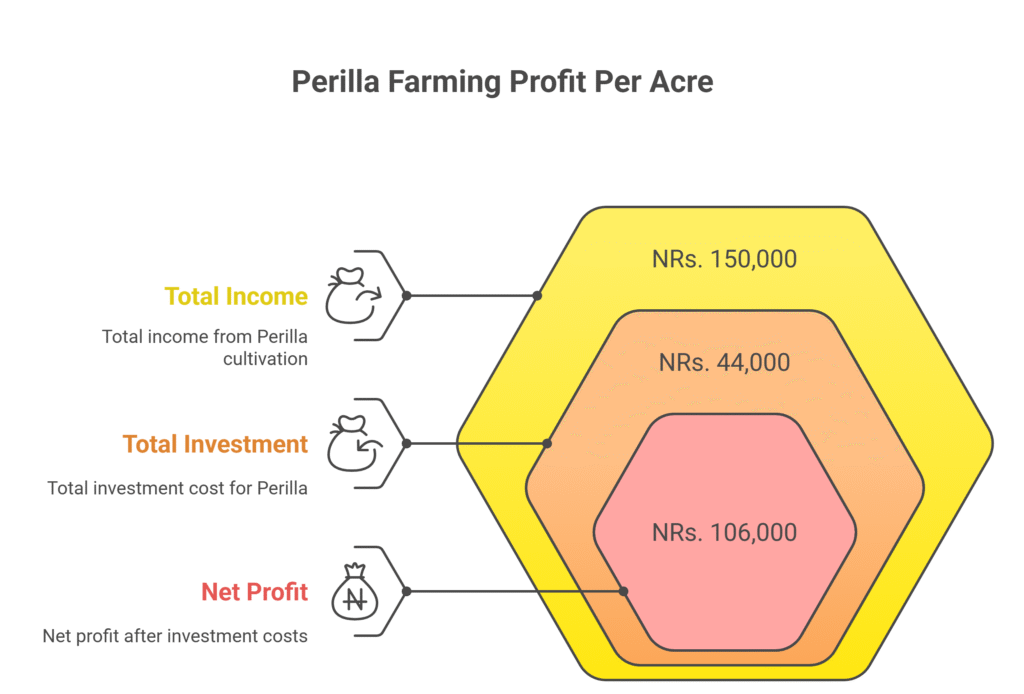
Overall, Perilla farming profit per acre demonstrates that with proper management practices, timely harvesting, and pest and disease control, farmers can achieve substantial financial gains from this versatile herb.
Land Preparation
Proper land preparation is essential for ensuring good germination and healthy plant establishment. The field should first be plowed deeply to a depth of 15–20 cm to break up hardpans, improve soil aeration, and facilitate root penetration.
After plowing, the land is harrowed two to three times to break large soil clods and achieve a fine, well-pulverized tilth. The field is then leveled to promote uniform water distribution and prevent waterlogging. In areas with heavy rainfall, raised beds about 1 meter wide and 15–20 cm high are recommended to improve drainage, with channels between beds aiding both irrigation and excess water removal.
Soil Type
Perilla grows best in well-drained sandy loam to loamy soils rich in organic matter, with an ideal pH range of 5.5 to 6.5, which is slightly acidic to neutral. The crop performs poorly in heavy clay soils that are prone to waterlogging or in highly saline and alkaline conditions, as these environments hinder proper root development and plant growth.
Climatic Requirements
Perilla is a warm-season crop that thrives in temperate to subtropical climates, with an optimal growth temperature between 18°C and 25°C (64°F–77°F). It is sensitive to frost and cannot tolerate freezing conditions.
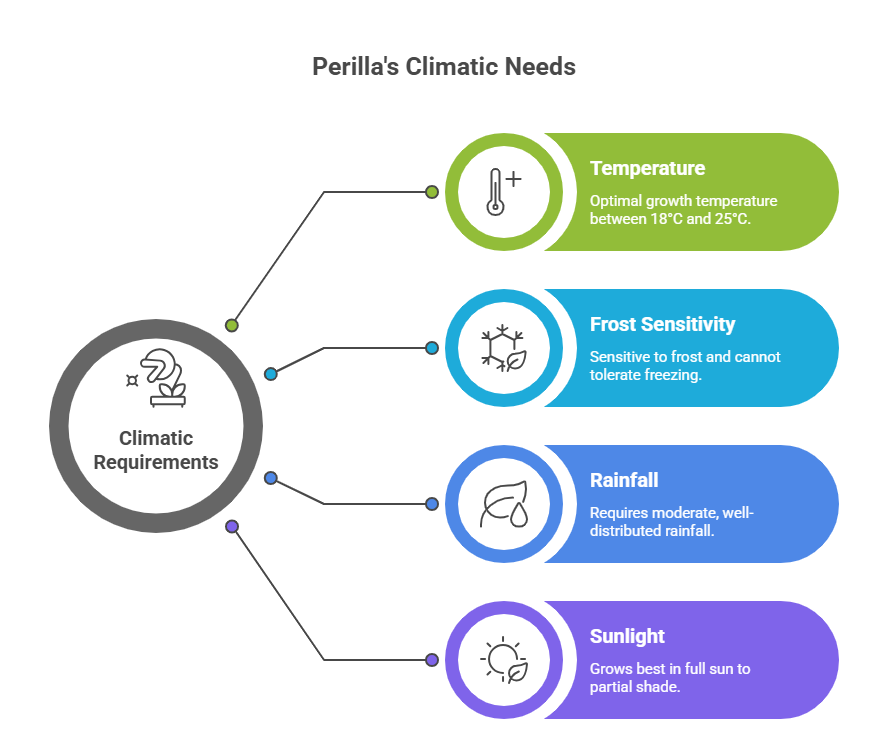
The crop requires moderate, well-distributed rainfall throughout the growing season, as both prolonged drought and excessive rainfall can negatively affect its growth. Perilla grows best in full sun to partial shade, with adequate sunlight being essential for vigorous growth and the production of essential oils responsible for its distinctive aroma.
Major Cultivars
Cultivars are primarily distinguished by their leaf color and use:
a). Perilla frutescens var. crispa (Shiso)
Perilla frutescens var. crispa, commonly known as Shiso, is primarily cultivated for its aromatic leaves. There are two main varieties: Aojiso (Green Shiso), which has green leaves with a refreshing minty-anise flavor commonly used in sushi, sashimi, and salads; and Akajiso (Red Shiso), which features purple-red leaves with a stronger, earthy flavor often used for coloring umeboshi (pickled plums) and in traditional beverages.
b). Perilla frutescens var. frutescens (Deulkkae)
Perilla frutescens var. frutescens, commonly known as Deulkkae, is primarily cultivated for its seeds, which are either pressed to extract oil or used as a spice. The cultivars of this variety are specifically selected for their high seed yield and superior oil content, making them valuable for both culinary and industrial purposes.
Propagation
Perilla is almost exclusively propagated by seeds.
Seed Rate per Acre
The seed rate for Perilla cultivation varies depending on the method used and the desired plant density. For direct seeding, approximately 0.5 to 0.75 kg of seeds are required per acre, while for transplanting, a smaller quantity of about 0.2 to 0.3 kg of seeds per acre is sufficient for raising seedlings in the nursery bed before field transplantation.
Nursery Management
Nursery management is an essential step in the transplanting method to ensure a healthy and uniform stand of Perilla plants. A small, finely tilled, and well-manured raised seedbed should be prepared for sowing. The tiny seeds are mixed with fine sand for even distribution and sown thinly on the bed surface, then lightly covered with a thin layer of soil or compost.
Regular, gentle watering is important to keep the seedbed moist but not waterlogged, and applying a light mulch of straw helps retain moisture. Seedlings are typically ready for transplanting after 3 to 4 weeks, once they reach 10–15 cm in height and have developed 4–5 true leaves.
Planting
a). Planting Season
In temperate regions, Perilla planting is carried out after the last frost in spring, once the soil temperature consistently remains above 15°C to ensure good germination. The typical planting window for optimal growth extends from late April to early June.
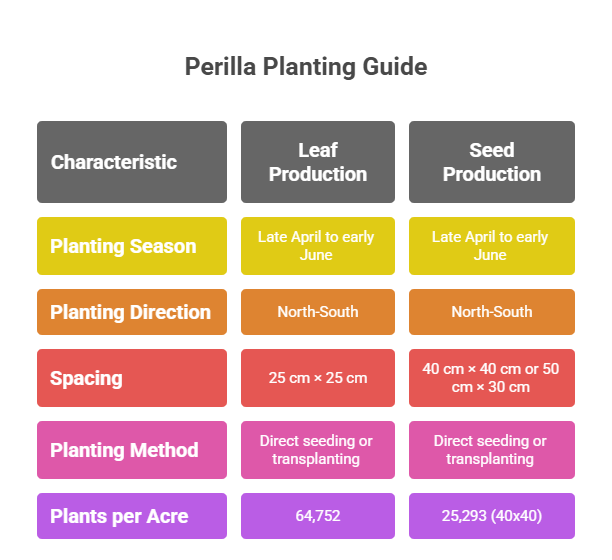
b). Planting Direction
Rows are typically oriented in a North-South direction to maximize sunlight exposure on both sides of the plants throughout the day.
c). Spacing
Spacing in Perilla cultivation depends on the purpose of production. For leaf production, a closer spacing of 25 cm × 25 cm is recommended to promote dense foliage and reduce early flowering. For seed production, wider spacing of 40 cm × 40 cm or 50 cm × 30 cm is preferred to allow plants to grow larger and bushier, resulting in higher seed yields.
d). Planting Method
Perilla can be established either through direct seeding or transplanting. In direct seeding, seeds are sown directly into the field in rows at the recommended spacing, and thinning is later performed to maintain proper plant-to-plant distance. In the transplanting method, seedlings raised in the nursery are carefully uprooted with a small ball of soil to minimize transplant shock and then planted into prepared pits, followed by immediate irrigation to help them establish quickly.
e). Number of Plants per Acre
| Spacing (cm × cm) | Approx. Number of Plants per Acre |
| 25 × 25 | 64,752 |
| 40 × 40 | 25,293 |
Intercropping
Perilla can be intercropped with compatible crops to optimize land use, with suitable companions including garlic, onions, and other low-growing leafy vegetables. However, it should not be planted alongside tall or aggressive crops that compete heavily for sunlight, water, and nutrients, as this can hinder its growth and productivity.
Irrigation
Perilla requires consistent moisture, particularly during germination, seedling establishment, and periods of active leaf growth. In the absence of rainfall, irrigation should be applied every 5–7 days, keeping the soil moist but avoiding waterlogging.
Drip irrigation is highly recommended as it conserves water, delivers moisture directly to the root zone, and keeps the foliage dry, thereby reducing the risk of fungal diseases. As the plants mature and approach harvest, watering should be slightly reduced to help concentrate the aromatic oils.
Fertilizer and Manure
Perilla responds well to organic fertilizers.
| Component | Type / Stage | Recommendation & Rate | Method of Application |
| Organic Manure | Basal Application (Before Planting) | 10 – 15 tons per acre | Incorporate thoroughly into the soil during final land preparation. |
| Biofertilizer | Basal Application (Before Planting) | Azospirillum + PSB (Phosphate Solubilizing Bacteria) + Potash Mobilizing Bacteria; 800 grams of each per acre | Mix with organic manure or apply in the planting rows/pits. |
| Chemical Fertilizer (NPK) | Basal Application (Before Planting) | 50:40:30 kg/acre of N:P₂O₅:K₂O. • Full dose of P (40 kg) & K (30 kg) • Half dose of N (25 kg) | Apply uniformly and mix into the soil before planting or transplanting. |
| Chemical Fertilizer (Nitrogen) | Top-Dressing | Remaining half dose of Nitrogen (25 kg/acre) | Apply 4-5 weeks after transplanting, during the active vegetative growth stage. Place near the plant base and lightly incorporate into the soil. |
Weed Control
Perilla requires consistent moisture, particularly during germination, seedling establishment, and periods of active leaf growth. In the absence of rainfall, irrigation should be applied every 5–7 days, keeping the soil moist but avoiding waterlogging.
Drip irrigation is highly recommended as it conserves water, delivers moisture directly to the root zone, and keeps the foliage dry, thereby reducing the risk of fungal diseases. As the plants mature and approach harvest, watering should be slightly reduced to help concentrate the aromatic oils.
Interculture Operation
Interculture operations for Perilla include pinching and pruning to promote healthy growth and higher yields. For leaf cultivars, pinching the top 2–3 cm of the main stem when the plant reaches 20–25 cm encourages bushy growth and delays early flowering by stimulating lateral branch development, thereby increasing leaf production. Regular pruning of yellow, diseased, or damaged leaves also improves air circulation and overall plant health.
Flowering and Fruit Management
Perilla is a short-day plant that initiates flowering as daylight decreases. For leaf production, flowering is undesirable because it makes the leaves bitter and stops further leaf growth, so regular pinching and harvesting help delay flowering.
In contrast, for seed production, plants should be allowed to flower; the small white or pinkish flowers grow on spikes, and after pollination, round seeds develop. Adequate water is essential during the flowering and seed-setting stages to ensure healthy seed formation.
Pest and Disease Management
Common Pests
a) Cutworms
Cutworms are soil-dwelling larvae that sever young seedlings at the base, causing significant stand loss in Perilla crops. To manage them, bait traps can be set using a mixture of bran, sugar, and a small amount of insecticide such as carbaryl (1–2 g per trap) around the seedlings.
Biological control options include applying Bacillus thuringiensis (Bt) formulations at a dose of 2–3 g per liter of water as a soil drench or foliar spray. Traps or treatments should be applied early in the season when seedlings are most vulnerable.
b) Aphids
Aphids suck sap from leaves, causing curling, yellowing, and stunted growth. They can be effectively controlled with neem oil applied at 5 ml per liter of water or insecticidal soaps at 2–3 ml per liter, sprayed thoroughly on the affected plants.
Sprays should be repeated every 7–10 days or after heavy rainfall until the infestation is under control. Encouraging natural predators like ladybugs can also help reduce aphid populations.
c) Spider Mites
Spider mites thrive in dry, hot conditions and cause fine stippling on leaves, leading to leaf discoloration and reduced photosynthesis. Increasing humidity around the plants or using miticides such as abamectin at 0.5 ml per liter of water can help manage infestations. Frequent monitoring is essential, and sprays should target the underside of leaves where mites congregate.
d) Caterpillars
Caterpillars feed on leaves, creating holes and sometimes defoliating young plants. Hand-picking larger caterpillars is effective for small infestations. For larger populations, Bacillus thuringiensis (Bt) can be applied at 2–3 g per liter of water as a foliar spray, which is safe for beneficial insects and highly effective against leaf-eating larvae. Applications should be repeated every 7–10 days if necessary.

Common Diseases
a) Damping-off
Damping-off is a fungal disease that affects seedlings, causing them to collapse and die at the soil line. To prevent this, use well-drained soil, avoid overwatering, and ensure proper spacing for good air circulation. For additional protection, treat seeds before sowing with a fungicide such as carboxin + thiram at a dose of 2 g per kg of seeds. Seedlings can also be lightly dusted with copper oxychloride at 3 g per liter of water if early signs of damping-off appear.
b) Leaf Spot
Leaf spot appears as small, circular, or irregular spots on leaves, which may be caused by fungi or bacteria. Infected leaves should be removed and destroyed to prevent spread. Improving air circulation through proper spacing and pruning helps reduce disease incidence. For chemical control, copper-based fungicides such as copper oxychloride can be sprayed at 3 g per liter of water, applied every 7–10 days, especially during humid conditions.
c) Root Rot
Root rot is caused by soil-borne fungi and is commonly observed in waterlogged or poorly drained soils. Symptoms include yellowing, wilting, and root decay. Prevention is key, so ensure proper drainage and avoid overwatering. For chemical control, soil drenching with metalaxyl + mancozeb at 2–3 g per liter of water can help manage early infections. Fungicide application should be done cautiously to avoid phytotoxicity and only when necessary.
Harvesting
Harvesting Perilla depends on the part of the plant being utilized. For fresh leaves, harvesting begins 40–50 days after transplanting, when plants reach 30–40 cm in height; individual leaves or the top 10–15 cm of stems can be cut, allowing for multiple harvests throughout the season.
For seed production, harvesting occurs 100–120 days after planting, when seed heads turn from green to brown and the seeds are hard and rattle in the pod. The entire seed spike is cut and dried in a well-ventilated area before threshing.
Yield
The yield varies significantly based on the cultivar, purpose, and management practices.
| Product Type | Expected Yield per Acre |
| Fresh Leaves | 2,000 to 3,000 kg |
| Dry Seeds | 500 to 800 kg |
Cost of Production of Perilla Per Acre
| S.N. | Categories | Cost for Investment (NRs.) |
| 1 | Land Preparation | 15,000 |
| 2 | Seed | 2,000 |
| 3 | Seed Sowing | 1,000 |
| 4 | Fertilizers and Manure | 8,000 |
| 5 | Irrigation | 6,000 |
| 6 | Weed Control (pre & post-emergence) | 2,000 |
| 7 | Pest & Disease Control | 2,000 |
| 8 | Harvesting | 3,000 |
| 9 | Miscellaneous Costs | 5,000 |
| Total Cost | 44,000 |
Income per acre from perilla farming
| Particulars | Estimated Yield / Acre (Kg) | Market Price (NRs / kg) | Total Income (NRs.) |
| Fresh Leaf Yield | 2,000 | 75 | 150,000 |
Analysis of Perilla Farming Per Acre
| Financial Metric | Calculation (NRs.) | Result (NRs.) |
| Total Income | – | 150,000 |
| Total Investment Cost | – | 44,000 |
| Net Profit | 150,000 – 44,000 | 106,000 |
| Profit Margin | (106,000 / 150,000) x 100 | ~70.7% |
| Return on Investment (ROI) | (106,000 / 44,000) x 100 | ~241% |
The financial analysis of Perilla cultivation shows a total income of NRs. 150,000 against a total investment cost of NRs. 44,000, resulting in a net profit of NRs. 106,000. This translates to a profit margin of approximately 70.7% and a return on investment (ROI) of around 241%, indicating a highly profitable venture.
ALSO READ : Thyme Farming Profit Per Acre
ALSO READ: Sorrel Farming Profit Per Acre
Crop Calendar of Perilla Farming (for Leaf Production)
This calendar is based on Spring planting season in a temperate climate, which is the most common cycle. Adjustments may be needed for different geographical locations.
| Period (Approx. 4-5 Month Cycle) | Key Growth Stage | Critical Operations & Activities |
| Late March – Early April (3-4 weeks before planting) | Nursery Establishment | · Prepare nursery bed: Create a fine, well-manured raised bed. · Sow seeds: Mix seeds with sand for even distribution, sow thinly, and cover lightly. · Nursery Care: Water gently to keep moist; apply light straw mulch. |
| Late April – Early June (Starting when soil >15°C) | Land Preparation & Planting | · Land Prep: Deep plow (15-20 cm), harrow 2-3 times, level the field. Prepare raised beds if needed. · Apply Basal Fertilizers: Incorporate 10-15 tons/acre of FYM/compost and full doses of biofertilizers, P, K, and half N. · Transplanting: Move 3-4 week old seedlings (10-15 cm tall with 4-5 leaves) to the main field at 25×25 cm spacing. Irrigate immediately. |
| Week 1 – 6 After Planting (Early Vegetative Stage) | Seedling Establishment & Early Growth | · Irrigation: Water every 5-7 days to maintain consistent moisture. Drip irrigation is ideal. · Weed Control: Perform 2-3 shallow manual weedings. Critical period is the first 4-6 weeks. · Pest Monitoring: Scout for cutworms, aphids, and other early-season pests. |
| Week 6 – 8 After Planting (Active Vegetative Stage) | Canopy Development | · Top-Dressing: Apply the remaining half dose of Nitrogen (25 kg/acre). · Interculture (Pinching): Pinch off the top 2-3 cm of the main stem when plants are 20-25 cm tall to encourage bushiness. · Continue irrigation and pest/disease monitoring. |
| Week 8 Onwards (Maturation & Harvest) | Leaf Production | · First Harvest: Begin harvesting leaves or stem tips ~40-50 days after transplanting. · Multiple Harvests: Conduct successive harvests throughout the season. · Reduce Irrigation: Slightly reduce watering to concentrate aromatic oils. · Pruning: Regularly remove yellow or diseased leaves. |
| ~100-120 Days After Planting (For Seed Production Only) | Flowering & Seed Maturation | · Stop leaf harvest and allow plants to flower. · Ensure adequate water during flowering and seed set. · Harvest seeds when seed heads turn brown and seeds rattle in the pod. Cut and dry entire spikes. |
| Post-Harvest | Field Management | · Remove and destroy old plant material to break pest and disease cycles. · Plan for crop rotation to maintain soil health. |
Sources
Food and Agriculture Organization (FAO)
University of California Agriculture & Natural Resources (UC ANR)
European Plant Protection Organization (EPPO)
Punjab Agricultural University (PAU)
Tamil Nadu Agriculture University (TNAU) – Agritech portal
Indian Council of Agricultural Research (ICAR)
Nepal Agricultural Research Council (NARC)
U.S. Department of Agriculture (USDA).
Ministry of Agriculture and Livestock Development (Nepal)
Disclaimer: This crop farming profits assume optimal conditions. Actual results may vary depending on climate, market prices, and farm management practices.
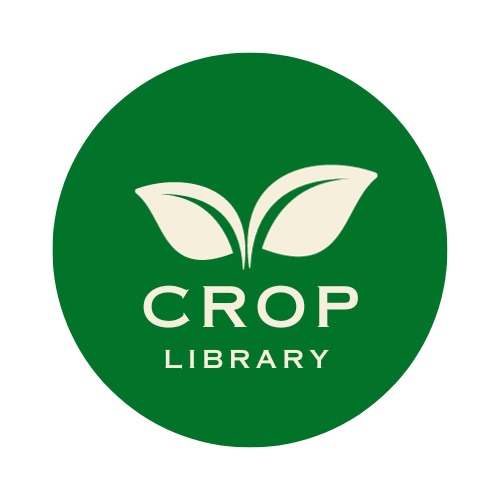

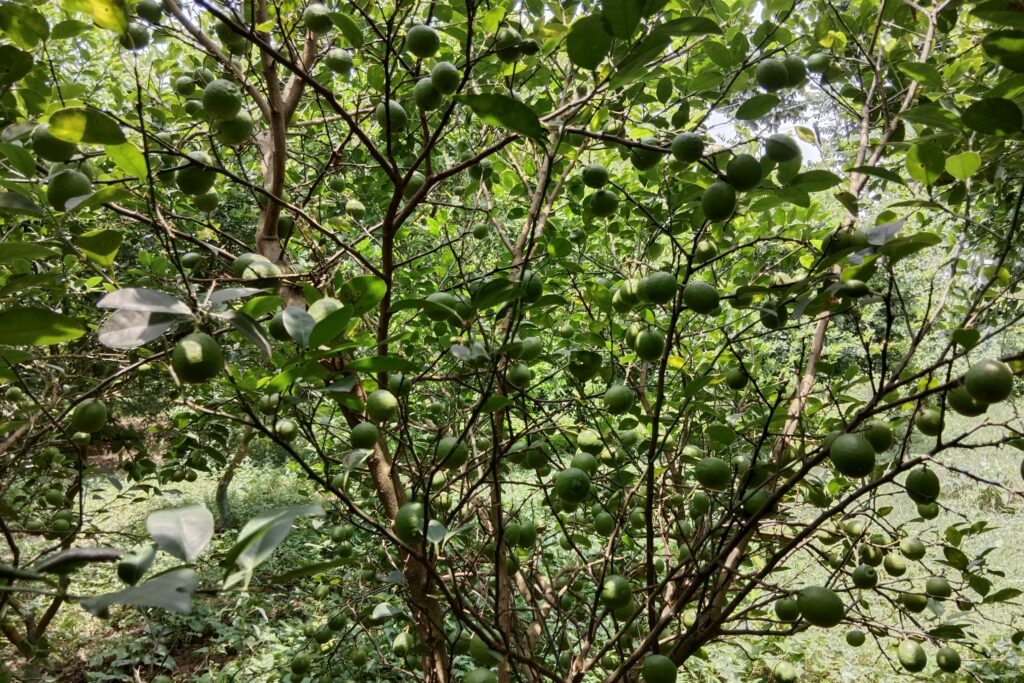
Pingback: Stevia Farming Profit Per Acre -